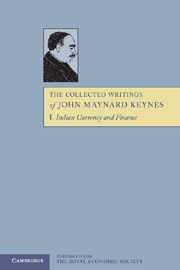Book contents
- Frontmatter
- Contents
- General introduction
- Editorial foreword
- Preface
- Dramatis personae
- 1 THE PRESENT POSITION OF THE RUPEE
- 2 THE GOLD-EXCHANGE STANDARD
- 3 PAPER CURRENCY
- 4 THE PRESENT POSITION OF GOLD IN INDIA AND PROPOSALS FOR A GOLD CURRENCY
- 5 COUNCIL BILLS AND REMITTANCE
- 6 THE SECRETARY OF STATE'S RESERVES AND THE CASH BALANCES
- 7 INDIAN BANKING
- 8 THE INDIAN RATE OF DISCOUNT
- Index
- Chart showing the rate of discount at the Presidency Bank of Bengal
3 - PAPER CURRENCY
Published online by Cambridge University Press: 05 November 2012
- Frontmatter
- Contents
- General introduction
- Editorial foreword
- Preface
- Dramatis personae
- 1 THE PRESENT POSITION OF THE RUPEE
- 2 THE GOLD-EXCHANGE STANDARD
- 3 PAPER CURRENCY
- 4 THE PRESENT POSITION OF GOLD IN INDIA AND PROPOSALS FOR A GOLD CURRENCY
- 5 COUNCIL BILLS AND REMITTANCE
- 6 THE SECRETARY OF STATE'S RESERVES AND THE CASH BALANCES
- 7 INDIAN BANKING
- 8 THE INDIAN RATE OF DISCOUNT
- Index
- Chart showing the rate of discount at the Presidency Bank of Bengal
Summary
The chief characteristics of the Indian system of currency have been roughly sketched in the first chapter. I will now proceed to a description of the system of note issue.
In existing conditions the rupee, being a token coin, is virtually a note printed on silver. The custom and convenience of the people justify this, so far as concerns payment in small sums. But in itself it is extravagant. When rupees are issued, the government, instead of being able to place to reserve the whole nominal value of the coin, is able to retain only the difference between the nominal value and the cost of the silver. For large payments, therefore, it is important to encourage the use of notes to the utmost extent possible-from the point of view of economy, because by these means the government may obtain a large part of the reserves necessary for the support of a gold-exchange standard, and also because only thus will it be possible to introduce a proper degree of elasticity in the seasonal supply of currency.
By Acts of 1839–43 the presidency banks of Bengal, Bombay, and Madras were authorised to issue notes payable on demand; but the use of the notes was practically limited to the three presidency towns. These Acts were repealed in 1861, when the present government paper currency was first instituted. Since that time no banks have been allowed to issue notes in India.
- Type
- Chapter
- Information
- The Collected Writings of John Maynard Keynes , pp. 26 - 44Publisher: Royal Economic SocietyPrint publication year: 1978



